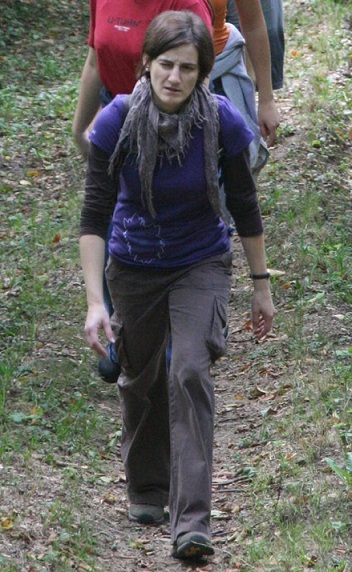Bakó Ambrus
Basa Brigitta
Beke Kornélia
Cseh Borbála
Csóti István
Erdős Vanda
Dr. Éva Csaba
Fodor Gábor
Gárdonyi Márk
Gyulavári Pál
Diplomamunka
A búzaszem keménységét meghatározó fehérjék szerkezet-funkció vizsgálata (2008)
Dr. Hornyák Péter
A tanszéken az ezredforduló táján kezdtem el dolgozni. A kutatási a témán a búza Bx7HMW glutenin alegység túltermelésének genetikai vizsgálata volt és egy olyan genetikai marker kifejlesztése, melynek segítségével a jobb lisztminőséget produkáló búzanövények kiválasztása jelentősen felgyorsulhat. Munkám során elsősorban molekuláris biológiai módszereket alkalmaztam, mint növényi DNS izolálás, klónozás szekvenálás és PCR.
Témámmal a 2003-as TDK-n is részt vettem, ahol negyedik helyezést értem el, továbbá abban a megtisztelésben részesültem, hogy munkám összefoglalóját a Magyar Tudományos Akadémián megrendezésre kerülő Növénynemesítési Tudományos napok keretében a poszter szekcióban prezentálhattam.
Jelenleg Angliában élek és a Sussex-i egyetemen mint poszdoktor dolgozom.
Horváth Mihály
Ivanics Milán
Jaanika Udam
 It was 2011 autumn, when I became a part of TLC group by pretty much an accident. As an Erasmus student from Estonia I had chosen a lecture called "Biology of crops", but as I was the only student interested, Tanár Úr had another proposal to me - to start "work on the bench" at his lab. At that time, it was my biggest dream come true and soon I started spending all my time at the lab learning different molecular biology techniques mainly under Dr. Csaba Éva.
It was 2011 autumn, when I became a part of TLC group by pretty much an accident. As an Erasmus student from Estonia I had chosen a lecture called "Biology of crops", but as I was the only student interested, Tanár Úr had another proposal to me - to start "work on the bench" at his lab. At that time, it was my biggest dream come true and soon I started spending all my time at the lab learning different molecular biology techniques mainly under Dr. Csaba Éva.
Instead of returning back home after one semester, I decided to stay for one and a half year more and continue work in TLC lab. The main topic of research I participated were wheat quality studies by studying the effects of puroindolines on wheat kernel hardness. In collaboration with Agricultural Institute (MTA) work continued by searching and testing new molecular markers for bread wheat kernel texture.
In 2013, under Prof. László Tamás supervision, I defended my Bsc thesis "Studying different molecular markers for kernel texture in bread wheat (Triticum aestivum L.)" in Univesity of Tartu. Shortly after, life took me on other roads than biology, though I was still hoping to return some day.
Currently, on maternity leave, I often think that if I should return someday to biology it would be to the TLC lab and it would be for its people as such a community or even may I call it a fellowship Prof. László Tamás has built is extraordinary.
So, even if you are "just" a Bsc student, TLC lab is perfect place to work hard, learn a lot and actually do some science in great atmosphere and good enviroment.
Szakdolgozat
Studying different molecular markers for kernel texture in bread wheat (Triticum aestivum L.) (2013) (University of Tartu)
Kiss Csaba
Kiss Eszter
Kremmerné Parczel Kata
Lukács Márk Sebestyén
Makai Szabolcs
Mohos Nikolett
Dr. Nagy Zsolt
Dr. Oszvald Mária 
2001-ben szereztem biomérnöki diplomát a BME-én. Ám elég messze sodródtam a mérnöki pályától, ami már az egyetem negyedik évfolyamán kezdődött. Mivel néhány tárgyat (genetika, molekuláris genetika) az ELTE-én hallgattunk, egy előadás alkalmával Tamás László tűnt fel az előadóban azzal a céllal, hogy diákokat invitáljon kutatási témájához. Nekem egy fél évig tartott, míg összeszedtem a bátorságom, és felkerestem, hogy szeretnék kutatómunkát végezni a csoportjában. Életem egyik legjobb döntése volt, mert innentől kezdve egy fantasztikus utazás kezdődött számomra a tudomány világában.
Rizs genetikai transzformálás volt a feladatom, melynek során búza tartalékfehérje gént próbáltam bejuttatni a rizs genomba. A siker nem jött azonnal, de szerencsére alkalmam volt folytatni a kutatást PhD keretében a diploma megszerzése után továbbra is a BME-én, de munka egy szerves részt a gödöllői Mezőgazdasági Kutatóintézetben és az ELTE-én végezve. És kiárult előttem a világ. A PhD éveim alatt két fantasztikus évet töltöttem el Prof Moon Sik Yang laboratóriumában, Dél Korában, Jeonju városában. Korea szerelmemmé vált, mert a doktori megszerzése után is többször visszatértem hosszabb-rövidebb időre. Hiszem, hogy az ott eltöltött időm segítette a két labor közötti kapcsolatot. Rengeteget tanultam mind szakmailag és emberileg is. Máig tartó barátságok születtek ott. És a koreai konyha számomra verhetetlen.
A PhD megszerzése után 2007-től az ELTE-én kezdetem dolgozni, mint tanársegéd. Időközben elnyertem egy OECD ösztöndíjat, mellyel 6 hónapot töltöttem a Murdoch University-n Perth-ben, Nyugat Ausztráliában. Itt további kísérleteket végeztem a már sikeresen létrehozott transzgénikus rizsnövényeimen. De haza kellett térni kenguruföldről, igaz nem sokat vesztegettem az időt magyar honban, mert 4 nap után ismét repülőre szálltam, hogy teljesítsek egy másik ösztöndíjat ezúttal az Egyesült- Királyságban Londontól nem messze egy kis városkában, Harpendenben a Rothamsted Research-ben. Itt megismerkedtem a lézer és transzmissziós mikroszkópia szépségeivel.
Majd sikeresen elnyertem egy pályázatot, mely három éves kutatási pénzt és fizetést biztosított. A téma a korábban lekezdett kutatási munka folytatása, azaz búza tartalékfehérjék vizsgálata rizs modell rendszerben volt. Az évek alatt volt két BSc, egy MSc és társ-témavezetésben egy PhD hallgatóm is. A pályázat lejártával azonban nem volt további lehetőségem a tanszéken maradni, így munka után kellett néznem. A munkakeresést személyes okokból az Egyesült –Királyságra koncentráltam. Végül 2015. áprilisától posztdoctorként Rothamsted Research-ben kezdtem el dolgozni egy teljesen más témában, ezúttal kukoricával és a cukor metabolizmus rejtelmeivel ismerkedem.
The green, green grass of Rothamsted (rádió interjú)
Poczkodi Edina
Sáfár Anna
2011-ben kezdtem el egyetemi tanulmányaimat az ELTE TTK Biológia szakán. Már az elején is világos volt számomra, hogy a növények érdekelnek leginkább, ezért 2013 februárjában, mikor úgy döntöttem, itt az ideje csatlakozni egy laborhoz, a Növényélettani és Molekuláris Növénybiológiai Tanszék honlapján is körülnéztem. Itt találtam rá az ehető vakcina témájára, és rögtön írtam is Tamás László csoportvezetőnek. Az első találkozásunkkor az volt a benyomásom, hogy el akar ijeszteni az egésztől, ezért természetesen annál inkább szerettem volna csatlakozni a csoporthoz. Pólya Sári nyomába szegődtem tehát a laborban, ő pedig minden technikát türelmesen megtanított nekem, ami a közös munka során szükségessé vált.
2013 novemberében a bioinformatika iránti érdeklődésemnek teret adva a Magyar Tudományos Akadémia Agrártudományi Kutatóközpont Alkalmazott Genomikai Osztályához csatlakoztam, ideiglenesen szüneteltetve a labormunkát. Makai Szabolcs vezetésével bioinformatikai eszközökkel tanulmányoztuk a tartalékfehérje gének szabályozásában résztvevő transzkripciós faktorok szekvenciáit.
2014 szeptemberétől ismét az ehető vakcina témájához tértem vissza, immár Zelenyánszki Helgával. A tavaszi félévtől azonban a laborban való részvételem a háttérbe szorult. Szakdolgozatom címe: Növényben termeltetett rekombináns fehérjék glikozilációs mintázatának módosítása géntechnológiai úton.
Dr. Solti Ádám
Egyetemi adjunktus
Azt a tényt, hogy egyszer biológusként szeretnék dolgozni, valamikor elsős, vagy másodikos általános iskolásként fogalmaztam meg magamban. Talán azért, mert ekkoriban kezdtem kaktuszokkal foglalkozni, talán ezért kezdtem el kaktuszokkal foglalkozni. Ki emlékszik már... Viszont mindkettő megmaradt :) Gimnazistaként főleg a növények ismerete, taxonómiája és a növénycönológia érdekelt. Nem volt kérdés tehát, hogy biológus szakra jelentkezzek az ELTE TTK-ra, és ne történész, kertészmérnök vagy agrármérnök legyen esetleg belőlem, mint lehetséges opciók. Az egyetem egy kicsit formálta az érdeklődésemet, így először a gombák irányába terelt, majd végül az élettani működéseknél kötött ki.
A Növényélettani és Molekuláris Növénybiológiai Tanszékre TDK-s hallgatóként jelentkeztem, és a kutatómunkát Sárvári Éva mellett kezdtem el. TDK-s, majd szakdolgozati munkámban a kadmium okozta nehézfémstressz hatásmechanizmusára fókuszáltam, és részben Basa Brigittával, aki szintén a szakdolgozatát készítette abban az időben a tanszéken, a kadmium által kiváltott fotoszintézisgátlás különböző aspektusait elemeztük. Brigi munkája a fénygyűjtő antennák megváltozott expressziójára irányult, míg magam a proteinkomplex-szerveződés, valamint a gerjesztési energia hasznosításának változásait elemeztem, munkánk során azonban mindketten intenzív kapcsolatba kerültünk Tamás László csoportjával. A szakdolgozatomat 2008-ban készítettem „A kadmium okozta fotoszintézisgátlás kivédése a vasellátás növelésével” címmel.
2008-tól PhD-hallgatóként folytattam a munkámat a tanszéken, Sárvári Éva és Tamás László közös témavezetése alatt. Fodor Ferenc nemzetközi együttműködésébe bekapcsolódva 2008-ban, 2009-ben, majd 2010-ben összesen több hónapot tölthettem kint Javier Abadía csoportjánál a spanyolországi Zaragozában (CSIC), ahol kloroplasztisz burkolómembrán fehérjék izoelektromos fókuszálásával próbálkoztunk meg, több-kevesebb sikerrel, valamint új modellnövényként a cukorrépát vezettem be a tanszéken folyó munkába. Szintén a spanyolországi tapasztalatokból kiindulva kezdtem még a PhD-munkám mellett a kloroplasztiszok vasfelvételi rendszerének a vizsgálatába, így a munka fókuszpontja is átkerült a kadmium okozta károsodások vizsgálatáról a növényi vasháztartás, különös tekintettel a kloroplasztiszok vasháztartásának a vizsgálatára.
A témából végül 2012-ben védtem meg a doktori disszertációmat „Cd-Fe interferencia a vasháztartásban és a fotoszintézisben” címmel.
A tanszéken 2011-től tanársegédként, és 2015-től adjunktusként dolgozok. Láng Ferenc tanár úrtól fokozatosan átvettem a Növényélettan főtárgyak fotoszintézis és speciális növényi anyagcsere óráit, valamint Sárvári Éva tanárnőtől a Növénybiológia főtárgy fényreguláció óráit. Részt veszek továbbá a tanszék különböző (alap szintű, fehérje gélelektorforézis, spektroszkópia és klorofill-a fluoreszcencia technikák) gyakorlatainak a megtartásában. Részt vettem a tanszék új elektronikus tankönyvének, valamint elektronikus gyakorlati jegyzetének az írásában. Jelenlegi kutatási témáim közé tartozik a kloroplasztisz vasháztartási rendszerének a fiziológiai, proteinkomplex-szerveződés, valamint génexpressziós szintű szabályozásának a vizsgálata, mely munka keretében kapcsolatot építettünk Ling Hong-Qing professzor csoportjával (Peking, Kína), valamint a Haberlea rhodopensis balkáni reliktum-endemizmus kiszáradás- és fagytűrése fiziológiai hátterének a feltárása, amely témában szorosan együttműködünk Katya Georgieva csoportjával (Bulgária, Szófia). A kloroplasztiszok vasháztartása vizsgálatának témájában több BSc, MSc és PhD hallgató végzett, illetve végez jelenleg is munkát a témavezetésem alatt.
Doktori
Cd-Fe interferencia a vasháztartásban és a fotoszintézisben (2012)
Szilvási Anikó
Téglás Flóra
Tóth Gábor
Diplomamunka
Genetikai szabályozás vizsgálata transzgénikus növények segítségével (2009)

